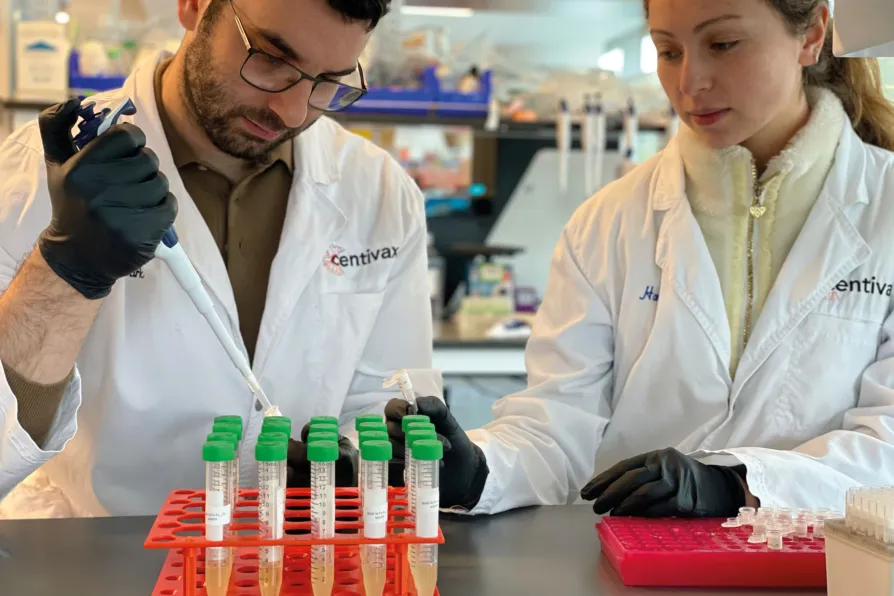The catastrophe unfolding in Gaza – where Palestinians are freezing to death in tents – is not a natural disaster but a calculated outcome of Israel’s ongoing blockade, aid restrictions and continued violence, argues CLAUDIA WEBBE
A maverick’s self-inflicted snake bites could unlock breakthrough treatments – but they also reveal deeper tensions between noble scientific curiosity and cold corporate callousness, write ROX MIDDLETON, LIAM SHAW and MIRIAM GAUNTLETT

 POISON: Centivax workers study antivenom to counteract the bites of various snakes at the company lab in San Francisco
POISON: Centivax workers study antivenom to counteract the bites of various snakes at the company lab in San Francisco
IN the 1660s, the Italian natural philosopher Francesco Redi started to investigate vipers at the urging of the Grand Duke of Tuscany. In his final work, Redi criticised previous writers on the topic, accusing them of parroting received wisdom.
One popular belief among scholars was that viper bile, produced in the snake’s liver, was also poisonous. Redi referred to a demonstration by a viper catcher who, after listening to the learned debate, “took a viper’s bile and diluting it with half a glass of fresh water, tossed it off with unflinching face; he gave to understand how mistaken the above-mentioned authors were.”
There is a rhetorical power to self-experimentation — particularly if it is dangerous. To see if colours were produced by pressure, Isaac Newton rammed a bodkin into his own eye. The Scottish surgeon John Hunter inoculated himself with pus from a patient with gonorrhoea to see if he would later get syphilis.
And in the 1980s, the Australian doctor Barry Marshall drank a solution of Helicobacter pylori to see if he would get stomach ulcers: he did, and won the Nobel prize. Marshall’s paper was published mentioning only a “male volunteer,” but it eventually became common knowledge that he was the volunteer.
The history of science is also full of examples of something more sinister: experiments on others without their permission. There is a long shadow cast by horrors such as the 40-year Tuskegee syphilis experiment. Beginning in 1932, the United States Public Health Service deliberately withheld treatment from over 400 black American men in Macon County, Alabama, just to see how their condition would progress.
Throughout the decades the men were lied to about the purpose of the study; they believed they were getting free healthcare, but in fact doctors were instructed not to give them the antibiotics that could have cured them. Most scientific experiments on human subjects are now subject to a lengthy process of ethical approval. But it would be wrong to think of this as sufficient.
For example, participants in clinical trials of new drugs are often paid for their time. But to discourage people from taking risks with their health for money, payments are usually kept low.
For example, one 2020 survey of challenge trials — where participants are deliberately given a disease while under observation — are paid at an average rate of just over £10 an hour, less than the minimum wage in Britain. Though money always risks creating economic coercion, this rate of pay attracts only those who need every penny: the poor and not the rich.
The pharmaceutical industry denies that commodification of people’s bodies takes place when people are paid. But that is obviously false: many volunteers in early-stage pharmaceutical trials are now repeat volunteers.
One survey found that 90 per cent of them “admitted that financial reward was the main reason to participate.” One said that “it’s a weird kind of work in a ‘mild torture economy’ in which I am paid not to produce something, but to endure something.”
Still, there are those who are willing to endure things most of us would consider torture out of personal fascination. One such enthusiast is Tim Friede, a self-taught snake expert. Friede is like a modern version of Redi’s viper catcher. Decades ago, he decided to deliberately tried to build up his immunity to snake venom.
He dried out venom and carefully weighed it, then injected tiny amounts into himself, gradually increasing the dose, trying to train his immune system to produce antibodies against the toxin. In 2001, he started experimenting with real snakes. But this proved dangerous, despite his self-dosing: “I was put in ICU after two cobra bites and I dropped in a coma for four days,” he told NPR recently.
The concept of antitoxin serum is an old one that goes back to the late 19th century, and not just for snakes. Scientists made treatments for bacterial diseases such as diphtheria by infecting horses, then extracting antitoxin from their blood to treat sick children.
The same concept can be used with people standing in for antibody-generating horses: during the Covid-19 pandemic, convalescent plasma therapy was used successfully to treat patients with blood extracts from people who had survived the disease.
We already have effective antivenom, but Friede’s phenomenal capacity to be bitten by many different species of snake means his blood must contain powerful forms that offer general protection.
But he’s just one man, and he can’t be bled dry to donate to every person that gets bitten. Instead, using his blood and working out the chemical composition of those antitoxins might allow them to be synthesised and made in large quantities, providing more effective and widely available treatment.
Last week, scientists published a paper in the journal Cell claiming to have found important new antivenoms from Friede’s blood: a cocktail combining two of them let mice survive bites from over 19 species of venomous snake. Much of the commentary has focused on the ethics of Friede’s self-experimentation and of the scientists in potentially encouraging him.
But zooming out, it’s worth noting that the study is a collaboration with a biotechnology company called Centivax, which is pursuing “universal immunity” treatments such as universal influenza vaccines.
This is an important and valuable goal. But of course, the aim is also profit. The lead author and co-founder, Jacob Glanville, has previously shown a talent for PR, a necessary part of any start-up: he claimed in March 2020 that his company was “3-4 weeks” from developing an antibody treatment for coronavirus — it didn’t materialise.
The venom paper is wacky and has secured wall-to-wall coverage for Centivax. But it doesn’t address the real problem for the 140,000 people who die from snakebites each year, or the 400,000 left with permanent disability — due to lack of access to already existing medicine.
Current antivenoms work well if given quickly, which is how Friede has survived his DIY trials in California so far. But most people do not deliberately get bitten by snakes, safe in the knowledge that high-quality healthcare is nearby.
As the venom expert Jean-Philippe Chippaux told Nature, it’s unlikely that newer antivenoms will solve this problem. Instead, “we need to think about ways to bring antivenoms closer to the areas where venomous snake bites occur.”

As food and fuel run out, Gaza’s doctors appeal to the world to end the ‘genocide of children,’ reports LINDA PENTZ GUNTER













